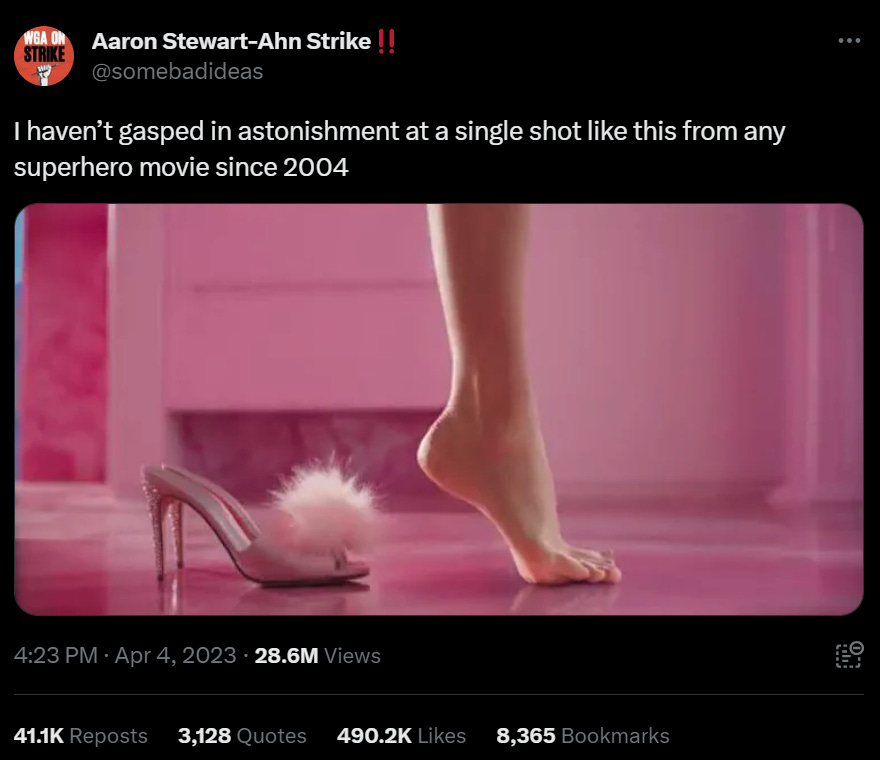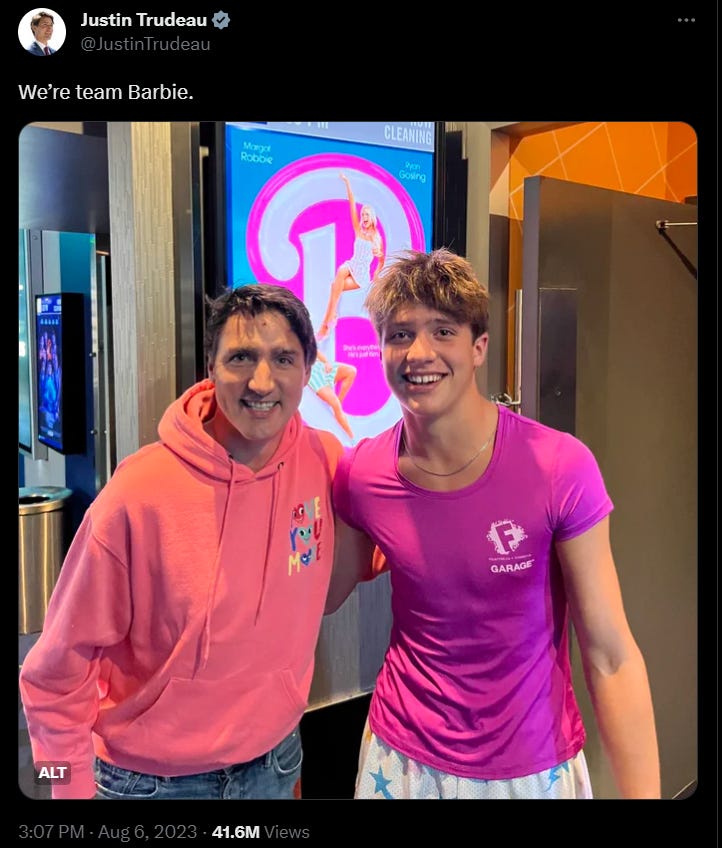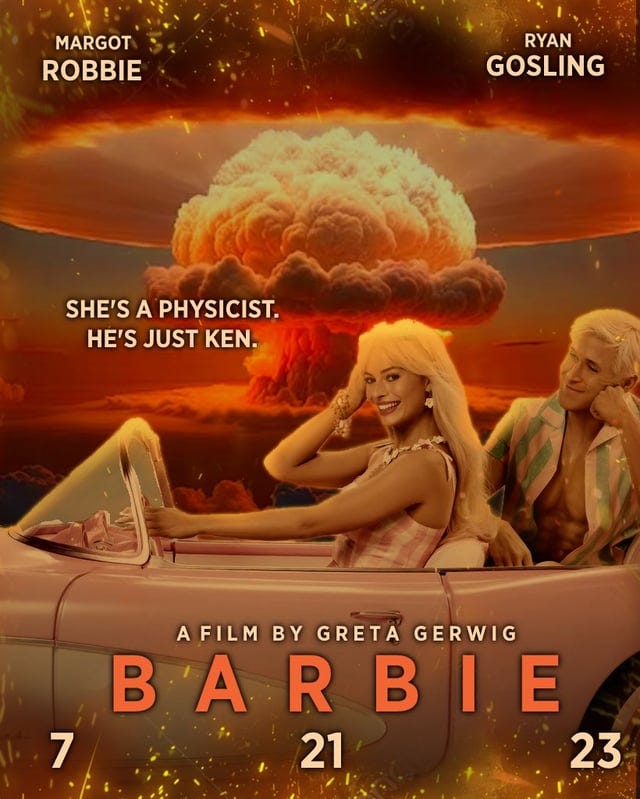How to go viral: Barbie’s billion dollar meme machine
Imagination, hype is your creation
Barbie has crossed $1 billion at the box office, propelled by historic hype. By now it’s a truism that the film had amazing marketing — but most of the hype around Barbie wasn’t part of the official marketing campaign. It wasn’t the ads, partnerships, or even real-life Dreamhouse that made Barbie ubiquitous.
It was the memes.
Not all heroes wear capes, and not all marketers wear employee badges. The non-stop surround-sound buzz that dominated our feeds for months came not from Warner Bros staff, but from online people making content for free.
That’s lucky for the rest of us, because Barbie’s official marketing campaign, while excellent, isn’t very instructive for companies that don’t have brand saturation and $150 million to work with. Virality, on the other hand, can be cultivated (and shots on goal cost nothing).
Of course, it’s impossible to guarantee something will become a meme — people are unpredictable and a lot of luck is involved — but you can engineer your content to have more luck.
This is the real lesson to take away from Barbie’s marketing: how to go viral by mobilizing the power of memes. There’s no single formula for bottling lightning, but here is what Barbie did.
1. Provide a good canvas
The key to getting people to latch onto a meme is to give them a good template, and Barbie provided a host of exquisite meme templates.
Memes can be in any format: text (e.g., “Some of you never xxxxx and it shows”), images (see below), or videos (e.g., Planet of the Bass), but images travel best. They get more of an algorithmic boost than text and are easier to edit than a video.
Here is a list of what makes an image meme-worthy, with examples using the content from Barbie.
It embraces absurdity
It’s visually arresting
It evokes emotion
It stokes debate
It invites people to make it personal, especially with any caption that starts with, “Me…” (more on this in the next point)
A lot of Barbie memes checked multiple categories, like being simultaneously absurd, visually striking, and personal.
In contrast, images like the ones below don’t accomplish any of those things and are accompanied by the kind of overt ask that would make any potential meme-maker cringe.
2. Put the “me” in “meme”
Barbie’s marketing campaign has the same key ingredient as Soylent Green: people.
Hype doesn’t happen without millions of people participating, and people are usually loath to share promotional content. But you know what they love to share? Self-promotional content.
That’s not disparaging; it’s a law of human nature. If you rank the things people like to talk about, number one is themselves (and number last is products and services).
So the best way to get people to share your content is to make your content a vehicle for people to talk about themselves. The most powerful memes involve some form of self-expression: what you are, what you feel, or what you believe.
To boost the virality of your content, make sure it gives people an opportunity to express:
Their sense of humor
Their opinions
Their cultural references
Their style or appearance
Their experiences
Barbie content provided a catalyst for people to share all those things, such as their:
Opinions
Against the backdrop of a national discourse obsessed with topics like womanhood, masculinity, and patriarchy or the lack thereof, Barbie became a vehicle for discussion and debate, with each side claiming it as evidence for their position.Style and appearance
People like to share pictures of themselves, especially in fun settings or nice outfits. Barbie explicitly encouraged people to insert themselves into content related to the film, with their selfie movie poster generator and life-sized toy boxes in theaters.Experiences
Barbie’s strong nostalgia factor prompted people to discuss and connect over their experiences playing with the dolls as children. Here’s a sweet example.Things got meta and the Barbie hype itself created shared experiences, resulting in gems like this.
3. Form a tribe
The biggest lie ever told was, “I don’t want to be labeled.” People freaking love to be labeled. That’s why people are perpetually enthralled with astrology, Buzzfeed personality quizzes (What type of croissant are you? Which romcon are you??) and whatever kind of labeling exercise this is:
 Tiktok failed to load.
Tiktok failed to load.Enable 3rd party cookies or use another browser
Joining a tribe, or a fandom, gives people a feeling of belonging with kindred spirits (e.g., fellow nostalgic millennials), while deepening their engagement with whatever that community is centered around (e.g., Barbie).
As I’ve written before about fandoms: Like religions, fandoms have symbols, rituals, shibboleths, and their own vernacular. They even enter into rivalries with other fandoms, which further deepens their sense of identity, connection to each other, and commitment to their favored band [or movie!].
All this makes people more likely to publicly signal their affiliation.
Barbie gave its fans no shortage of shibboleths, from the “Hi Barbie” greeting to the color pink. It made people feel like part of a community.
The real Barbie marketing campaign was, literally, the friends we made along the way.
And the coevality with Oppenheimer only heightened Barbie fans’ sense of group identity — the comically stark contrast between the two films basically made for a giant Buzzfeed personality quiz, letting people sort themselves and defend their camp.
The Barbenheimer dichotomy even became a symbol of choosing a side:
4. Find a great foil, aka the Barbenheimer effect
This is hard to do, but if you can find a great foil, it makes your own brand stand out more and rallies loyalists around the flag (see: RyanAir mocking the high prices and baggage fees of other airlines, Samsung positioning itself against iPhones, or Lyft making a marketing push during the #DeleteUber campaign).
The Barbenheimer phenomenon was a virality amplifier and an absolute gift for both Barbie and Oppenheimer. In addition to stoking rivalry and tribal loyalties, Barbenheimer provided the perfect meme canvas, combining every kind of meme fodder at the same time.
Going back through the list I described earlier:
It was totally absurd
It had arresting visuals
It evoked strong emotions
It stoked debate
It invited people to make a statement about themselves
Conclusion
Beyond the big-ticket marketing campaign, Barbie also gave us a master class in hyping a product for free: by getting other people to do it. The dynamics I described above can be seen in the McDonalds’ Grimace Shake trend and other viral brand moments — watch closely next time one pops.
There are no guarantees of virality even if you have a big budget and name recognition, but by creating meme-able content, centering your audience instead of yourself, inviting connection, and building in the right incentives, you can increase the odds of a lightning strike.
Barbie has been a doctor, an astronaut, and a president — and now she has become a poaster. She’s relatable at last.























Once again, solid analysis written in an approachable, relatable way. BTW, DEEPLY disappointed in the lack of a spoiler tag -- I had no idea about Soylent Green’s main ingredient and I was gonna watch that movie tonight!! 😂
Definitely a lot of excellent food for thought here. Question though:
How do you balance self promotional content without bragging?